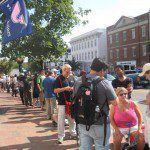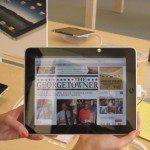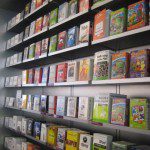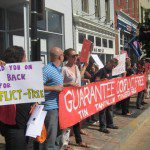Enter the iLife
By • June 18, 2013 0 1284

There was a little bit of a ruckus in the neighborhood last Friday. Perhaps you noticed it?
Okay, unless you rather presciently avoided lower Wisconsin around rush hour, unplugged your television and modem for the day or simply live in a cave, there’s probably no conceivable way you didn’t hear about the afternoon opening of the District’s first Apple store, the latest of the glass-housed, sleek-walled temples of cool to be added to the tech world’s register. The store, which last year gracefully navigated Georgetown’s notorious crucible of historical preservation edicts, had been so ceaselessly ballyhooed and elevated in the news and blogosphere that the formal announcement of the opening two weeks ago seemed a kind of deflated letdown, the journey’s quiet terminus, a gentle nudge to remind us that, oh yeah, it is just a store.
Yet no one in the snaking, variegated line of the iFaithful, stretching down 150 yards and curling around to M Street, seemed to believe that. In fact, if the Apple zeitgeist has taught us anything the past decade, it’s that the company (and the culture devoted to it) does nothing quietly, nor does it — ahem — simply open retail stores. Once dismissed as a caricature of serious computing, the PC’s irksome kid brother grew up in the 2000s into a hipster wunderkind, a sexy foil to the boxy, metallic slabs that spoonfed office drones their daily dose of Solitaire, PowerPoint slides and the occasional fatal blue screen. With a Mac, you could do stuff, the stuff that mattered, everything from mixing audio to launching a blog to renovating your baby videos with tasteful scene cuts and pop music overdub. By the end of the decade, the Mac, with the help of a take-no-prisoners marketing campaign, has become a rally point for the poets and painters of the digital age, a muse for the everyman, a culture where creation, not computation, is the watchword. The Harvard-pedigreed world of Bill Gates doggedly pursued productivity; Apple made it all about artistry. Later developments, such as the iPod and iPhone, have so securely cemented themselves in the popular consciousness and vernacular that they became must-haves for any consumer, status symbols of a plugged-in generation.
Co-founder Steve Jobs, who got the boot from company leadership in the ’80s before remanning the helm a decade later to launch its 21st-century renaissance, is to be congratulated, of course. Slinking around in a black turtleneck, bespectacled and spectacularly smiling, he is the most ungeekly of the geeks, a man with bottomless charisma and a fearsomely good nose for the trends and memes that spring up in the daily chaos of the tech universe. More impressive is his role as the face of Apple — he embodies it, more than any famous face they can air on TV, more than Einstein, more than Yo-Yo Ma, more than Justin Long, the actor who since 2006 personified the Mac’s “cool” image opposite a dweebish PC wonk. The world knows well that Jobs is the compass, the poster boy, the shepherd tending a technophile flock.
And as we saw late last year with the iPad, he still has it. He strolls on stage, a cool customer amid a mob of reporters and rabid fans, dazzling them every time. At Apple there is a sort of bloodless revolution going on, with Jobs and a million Macolytes perched on the barricades.
It all begs the question: what would the sleek tech juggernaut want with static, fastidious Georgetown, especially when younger, hipper neighborhoods are springing up downtown and on Capitol Hill? The answer, as Apple’s Ilene McGee coyly suggested, may be self-evident.
As she led a small group of reporters around the store moments before the doors were thrown open to the public, I asked McGee, the regional director for Apple stores in the metropolitan area, why Georgetown was selected as the site of the District’s first, and for now, only planned Apple store.
“Why wouldn’t you pick Georgetown?” she responded. She added, quietly, that the decision was made from on high, as if it were calculated from the top.
If nothing else, the decision did not go unnoticed. When the buzz began in 2008, the concept drew both excitement and consternation from citizens, who wondered how Apple’s modernist, minimalist layout of its stores would even begin to fit in with Georgetown’s vaguely termed “historic fabric.” In early 2009, The Old Georgetown Board hewed so strictly to the neighborhood’s architectural dictums that it sent the blueprints through the wringer five times before they were approved.
Chairman Ron Lewis of ANC 2E, which vets architectural designs before their review by the OGB, seemed to have overcome any doubts his commission may have had.
“It’s great having Apple in Georgetown,” he said. “[The company] obviously saw the draw of being in Georgetown, and the design process worked out very well in the end.”
Walking through the doors for the first time, before the mad rush of customers, was like walking into a good library — there’s this pristine, sacred feel, a small whispering sound as if the tomes — or in this case, gadgets — contained within are passing information between one another. Up front is propped the company’s latest flagship toy, the iPad, just begging to be fiddled with. Behind it are the iPhones (and in a few days’ time, presumably, the new fourth-generation arrivals). Arranged throughout the store are display stands of Apple iMacs, Apple MacBooks, Apple software packages and Apple accessories below looming, backlit posters of Apple slogans. If it isn’t a cult, it’s most certainly a culture.
Georgetown’s store contains the standard trappings, including the Genius Bar (for tech support) and a kid’s center, a petite bank of eight computers where children can attend a three-day filmmaking camp for free. The store will also offer the company’s popular “One to One” computer training, this time in a truly unique venue: an indoor “courtyard” at the store’s rear, scattered with high wood tables dunked in sunlight that pours through a glass rooftop. McGee said the architecture is only the second of its kind among Apple stores worldwide.
“We’re so excited to be a part of the Apple-Georgetown community,” she said, all but quaking with enthusiasm.
Outside, the street milled with customers lined up behind a velvet rope. Most were unabashed Apple zealots — even though few had any plans to purchase anything that day, in part because they already own their share of iPods and OS X flavors.
Bob Schadler, who hopped in line an hour and a half before the official opening time, said he already owned several Apple computers. Next to him, Amy, who declined to give her last name, boasted that four iPhones circulate around her household.
“My whole family’s pretty much Mac,” she said. Neither intended to buy anything that day.
Ditto for West End resident Hannah Lockhart, the proud owner of an iPod, Macbook and iPhone. However, her friend Becky Hayes did say she had her eye on the “awesome” iPad.
For his part, Ward 2 Councilmember Jack Evans, who made a brief appearance at the kickoff, was pleased with the community’s reception.
“This is a real shot to Georgetown,” he said. “It really affirms that Georgetown is a retail mecca.” Given the ongoing economic slump, he hoped the opening would drum up business for surrounding retailers.
Moments before the appointed hour, an army of blue-shirted store employees sprinted up from the back of the line, high-fiving, shouting, fomenting excitement. It wasn’t hard to build a frenzy. When the doors opened the blue-shirts had formed a cheering gauntlet along the center aisle, and the world flooded in.
I watched for a minute, smiled and left. It’s finally here. Enjoy, Georgetown.
- A long line of excited customers gathered moments before the Apple store opening on June 18. | Charlene Louis





